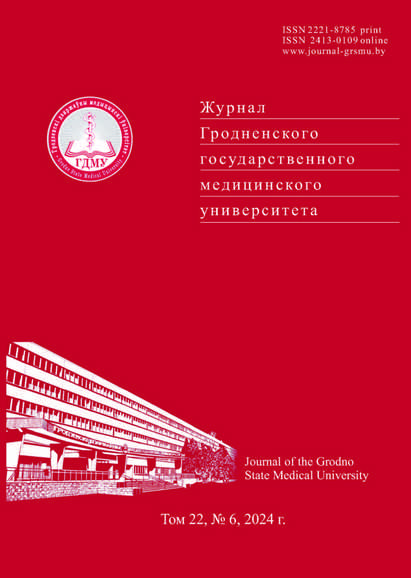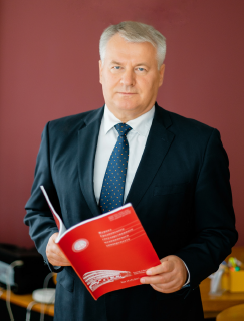МЕТОДИКИ ЭЛЕКТРОИМПЕДАНСОМЕТРИИ ДЛЯ НЕИНВАЗИВНОГО КОНТРОЛЯ СОСТОЯНИЯ ОРГАНИЗМА

Аннотация
В статье рассматриваются отдельные методики электроимпедансометрии (биоимпедансный анализ, биоимпедансная спектрометрия, биоимпедансный векторный анализ, метод сегментарного биоимпедансного анализа, многочастотный биоимпеданс, локальный биоимпедансный анализ, электроимпедансная томография) с точки зрения возможности применения как в биологическом эксперименте, так и в медицинской практике в качестве неинвазивных методов исследования в качестве альтернативы более трудоемким инвазивным методам, позволяющим получать информацию, не внося в организм изменений или риска развития осложнений. Обсуждаются возможности применения некоторых методик биоимпедансного анализа в клинических условиях. Обоснованное применение данного метода подразумевает знание и учет взаимосвязей между составом тела и электрофизическими свойствами каждого сегмента как в норме, так и при патологии с целью повышения эффективности лечения, улучшения прогноза и результативности, повышения качества диагностики.
Литература
de-Mateo-Silleras B, de-la-Cruz-Marcos S, Alonso-Izquierdo L, Camina-Martín MA, Marugán-de-Miguelsanz JM, Redondo-Del-Río MP. Bioelectrical impedance vector analysis in obese and overweight children. PLoS One. 2019;14(1):e0211148. https://doi.org/10.1371/journal.pone.0211148.
Bartels EM, Sørensen ER, Harrison AP. Multi-frequency bioimpedance in human muscle assessment. Physiol Rep. 2015;3(4):e12354. https://doi.org/10.14814/phy2.12354.
Tornuev YV, Nepomnyaschikh DL, Nikityuk DB, Lapiy GA, Molodykh OP, Nepomnyaschikh RD, Koldysheva EV, Krinitsyna YM, Balakhnin SM, Manvelidze RA, Semenov DE, Churin BV. Diagnostic capability of noninvasive bioimpedance. Fundamental research. 2014;(10-4):782-788. edn: SVQWLV. (Russian).
Nikolaev DV, Shchelykalina SP. Bioimpedance analysis of human body composition: medical applications, terminology. Clinical nutrition and metabolism. 2021;2(2):80-91. https://doi.org/10.17816/clinutr72132. https://www.elibrary.ru/cpvvml. (Russian).
Zlochiver S, Arad M, Radai MM, Barak-Shinar D, Krief H, Engelman T, Ben-Yehuda R, Adunsky A, Abboud S. A portable bio-impedance system for monitoring lung resistivity. Med Eng Phys. 2007;29(1):93-100. https://doi.org/10.1016/j.medengphy.2006.02.005.
Banerjee A, Jafar AJN, Mukherjee A, Solomonides C, Witt E. Clinical SAQs for the Final FRCEM. Oxford: Oxford University Press; 2019. Chap. 5, Dermatology; p.71-82. https://doi.org/10.1093/med/9780198814672.003.0005.
Lukaski HC, Vega Diaz N, Talluri A, Nescolarde L. Classification of Hydration in Clinical Conditions: Indirect and Direct Approaches Using Bioimpedance. Nutrients. 2019;11(4):809. https://doi.org/10.3390/nu11040809.
Toso S, Piccoli A, Gusella M, Menon D, Bononi A, Crepaldi G, Ferrazzi E. Altered tissue electric properties in lung cancer patients as detected by bioelectric impedance vector analysis. Nutrition. 2000;16(2):120-4. https://doi.org/10.1016/s0899-9007(99)00230-0.
Sangkum L, Liu GL, Yu L, Yan H, Kaye AD, Liu H. Minimally invasive or noninvasive cardiac output measurement: an update. J Anesth. 2016;30(3):461-80. https://doi.org/10.1007/s00540-016-2154-9.
Blanco-Almazan D, Groenendaal W, Lozano-Garcia M, Estrada-Petrocelli L, Lijnen L, Smeets C, Ruttens D, Catthoor F, Jane R. Combining Bioimpedance and Myographic Signals for the Assessment of COPD During Loaded Breathing. IEEE Trans Biomed Eng. 2021;68(1):298-307. https://doi.org/10.1109/TBME.2020.2998009.
Hahn G, Frerichs I, Kleyer M, Hellige G. Local mechanics of the lung tissue determined by functional EIT. Physiol Meas. 1996;17 Suppl 4A:A159-66. https://doi.org/10.1088/0967-3334/17/4a/020.
Bioimpedance Devices for the Assessment of Body Fluid Volume for Patients Undergoing Dialysis: A Review of the Clinical Effectiveness, Cost-Effectiveness and Guidelines – An Update [Internet]. Ottawa (ON): Canadian Agency for Drugs and Technologies in Health. Available from: https://www.ncbi.nlm.nih.gov/books/NBK268826/
Raval NY, Squara P, Cleman M, Yalamanchili K, Winklmaier M, Burkhoff D. Multicenter evaluation of noninvasive cardiac output measurement by bioreactance technique. J Clin Monit Comput. 2008;22(2):113-9. https://doi.org/10.1007/s10877-008-9112-5.
Lee AJ, Cohn JH, Ranasinghe JS. Cardiac output assessed by invasive and minimally invasive techniques. Anesthesiol Res Pract. 2011;2011:475151. https://doi.org/10.1155/2011/475151.
Technology Assessment Conference on Bioelectric Impedance Analysis in Body Composition Measurement. Bioelectrical Impedance Analysis in Body Composition Measurement : National Institutes of Health Technology Assessment Conference Statement, 1994 December 12-14; Bethesda, Maryland. Bethesda : NIH Office of Medical Applications of Research; 1994. 35 p.
Vassilieva G, Gordienko K, Sidorenko D, Shchelykalina S, Batalova E, Tomilovskaya E, Gimadiev R, Nosovsky A, Larina I. Dynamics of Body Composition Indices and Biochemical Parameters in Participants of Countermeasure-Free 21-Day "Dry" Immersion. Human Physiology. 2021;47:296-305. https://doi.org/10.1134/S0362119721030178.
Kotanko P, Levin NW, Zhu F. Current state of bioimpedance technologies in dialysis. Nephrol Dial Transplant. 2008;23(3):808-12. https://doi.org/10.1093/ndt/gfm889.
Strokov AG, Poz YL, Gavrilin VA, Kopylova JV, Kryshin KN, Kutuzova AV, Terehov VA. Bioimpedance analysis in haemodialysis practice: short review and single center experience. Russian Journal of Transplantology and Artificial Organs. 2012;14(1):59-65. edn: NKKQNS. (Russian).
Mansouri S, Alharbi Y, Alshrouf A, Alqahtani A. Cardiovascular Diseases Diagnosis by Impedance Cardiography. J Electr Bioimpedance. 2022;13(1):88-95. https://doi.org/10.2478/joeb-2022-0013.
Bernstein DP. Impedance cardiography: Pulsatile blood flow and the biophysical and electrodynamic basis for the stroke volume equations. J Electr Bioimp. 2010;1:2-17.
Mamatov BM, Villevalde SV, Klimenko AS, Kobalava ZD. Bioimpedance vector analysis for detecting subclinical congestion in patients with decompensated heart failure. Clin Pharmacol Ther. 2016;25(5):45-49. edn: YQAGIP. (Russian).
Mansouri S, Alharbi Y, Haddad F, Chabcoub S, Alshrouf A, Abd-Elghany AA. Electrical Impedance Tomography – Recent Applications and Developments. J Electr Bioimpedance. 2021;12(1):50-62. https://doi.org/10.2478/joeb-2021-0007.
Mobarak M, Kadir MA, Siddique-E Rabbani K. Probing Deep Lung Regions using a New 6-electrode Tetrapolar Impedance Method. J Electr Bioimpedance. 2023;13(1):116-124. https://doi.org/10.2478/joeb-2022-0016.
Bodo M, Mahon R, Razumovsky A, Kouperberg E, Crimmins M, Armonda R, Baruch M. Comparison of cerebrovascular reactivity tests: a pilot human study. J Electr Bioimpedance. 2017;8:25-33. https://doi.org/10.5617/jeb.3939.
Scotland G, Cruickshank M, Jacobsen E, Cooper D, Fraser C, Shimonovich M, Marks A, Brazzelli M. Multiple-frequency bioimpedance devices for fluid management in people with chronic kidney disease receiving dialysis: a systematic review and economic evaluation. Health Technol Assess. 2018;22(1):1-138. https://doi.org/10.3310/hta22010.
Khalil SF, Mohktar MS, Ibrahim F. The theory and fundamentals of bioimpedance analysis in clinical status monitoring and diagnosis of diseases. Sensors (Basel). 2014;14(6):10895-928. https://doi.org/10.3390/s140610895.
Di Vincenzo O, Marra M, Di Gregorio A, Pasanisi F, Scalfi L. Bioelectrical impedance analysis (BIA) – derived phase angle in sarcopenia: A systematic review. Clin Nutr. 2021;40(5):3052-3061. https://doi.org/10.1016/j.clnu.2020.10.048.
Zharnov AM, Koniukh EA, Zharnova OA, Chekel AVBogdanovich VCh, Bashun NZ. The application of bioimpedance vector analysis in the assessment of biophysical parameters of component composition of the body and hydration status of various gender and age population groups with impaired renal disorders. Vesnik of Yanka Kupala State University of Grodno. Series 5. Economics. Sociology. Biology. 2021;11(2):132-139. edn: PWOOPY. (Russian).
Norman K, Stobäus N, Pirlich M, Bosy-Westphal A. Bioelectrical phase angle and impedance vector analysis – clinical relevance and applicability of impedance parameters. Clin Nutr. 2012;31(6):854-61. https://doi.org/10.1016/j.clnu.2012.05.008.
Lukaski HC, Moore M. Bioelectrical impedance assessment of wound healing. J Diabetes Sci Technol. 2012;6(1):209-12. https://doi.org/10.1177/193229681200600126.
Shi Y, Yang Z, Xie F, Ren S, Xu S. The Research Progress of Electrical Impedance Tomography for Lung Monitoring. Front Bioeng Biotechnol. 2021;9:726652. https://doi.org/10.3389/fbioe.2021.726652.
Aleixo GFP, Shachar SS, Nyrop KA, Muss HB, Battaglini CL, Williams GR. Bioelectrical Impedance Analysis for the Assessment of Sarcopenia in Patients with Cancer: A Systematic Review. Oncologist. 2020;25(2):170-182. https://doi.org/10.1634/theoncologist.2019-0600.
Bodenstein M, David M, Markstaller K. Principles of electrical impedance tomography and its clinical application. Crit Care Med. 2009;37(2):713-24. https://doi.org/10.1097/CCM.0b013e3181958d2f.
Barber CC, Brown BH, Freeston IL. Imaging spatial distributions of resistivity using applied potential tomography. Electronics Letters. 1983;19(22): 933-935. https://doi.org/10.1049/el:19830637
Raneta O, Bella V, Svec J. Electrical impedance mammography in the diagnostics of mammary gland diseases. Anta Medica. 2010;4(2):24.
Brown BH. Electrical impedance tomography (EIT): a review. J Med Eng Technol. 2003;27(3):97-108. https://doi.org/10.1080/0309190021000059687.






























